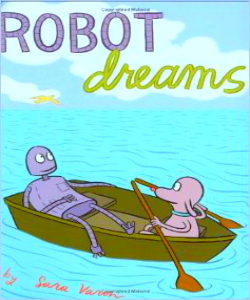
The Horn Book website has lots of material of interest to teachers. Here are some areas to explore. And follow us on Twitter: #lollysclass
|
Interviews with authors and illustrators Recommended books -- reviews and themed book lists |
School -- reading in school, author visits, and more Suggestion box: what else to you want to see in Lolly's Classroom? |
Using wordless books in the classroom
It is easy to underestimate wordless (or nearly wordless) picture books.
 The Arrival by Shaun Tan
The Arrival by Shaun TanThis book tells a universal tale of immigration through pictures of a man travelling to an alien world in search of work and a better life. The retro-futuristic setting, sepia-toned images, and alien language will make this book relatable to any reader. Geared towards middle school or older readers, this book could be used in a social studies or history class while reading about the immigrant experience in the U.S. and could just as easily be used in a literature class to teach students how to “read” images.
 Robot Dreams by Sara Varon
Robot Dreams by Sara VaronIt might seem surprising to say that a wordless book about a robot and a dog who are friends packs an emotional punch, but that is certainly the case here. Varon successfully uses images to pull readers into the story and vividly convey emotions without the need for dialogue. The bright colors of the drawings will make this book appealing and accessible to readers in third and fourth grade, where it can be used to prompt discussions around friendship and how art can prompt an emotional reaction.
 The Mysteries of Harris Burdick by Chris Van Allsburg
The Mysteries of Harris Burdick by Chris Van AllsburgThough not completely wordless, this book from famed writer and illustrator Chris Van Allsburg is definitely not a typical picture book. It consists of a series of drawings, each of which has a title and a caption and no further words associated with it. While the drawings all share an odd, off-kilter quality that makes them mysterious and not quite of our world, they are not explicitly connected to one another. As such, they make ideal short story prompts for virtually any age. This book could be used as inspiration for creative writings projects from grade school through high school. If you don’t believe me, you need look no further than the new version of the book published in 2011 under the name The Chronicles of Harris Burdick, which included a story written by a best-selling author to accompany each of the pictures.
 Mirror by Jeannie Baker
Mirror by Jeannie BakerHere the wordless format is combined with a unique physical format that has readers unfolding each side of the book to reveal side-by-side images of two families, one living in Sydney, Australia and the other living in a small town in Morocco. This layout juxtaposes life in these two locations, showing readers the differences but also the important similarities between the two families. This is an ideal book for younger readers from preschool through early grade school, who will delight in pointing out the similarities and differences between the images. It would work well for teaching vocabulary related to the images as well as for larger discussions about cultural differences around the world.
I hope these ideas will encourage some readers to reconsider the place of wordless books in their classes, but beyond this, I would also love to hear how readers have already been using them. I hope you’ll consider sharing your favorite wordless books and how you use them in your curriculum in the comments!
RELATED
RECOMMENDED
ALREADY A SUBSCRIBER? LOG IN
We are currently offering this content for free. Sign up now to activate your personal profile, where you can save articles for future viewing.







Add Comment :-
Comment Policy:
Comment should not be empty !!!
Julie Wilson
Yes, please, more wordless books in the classroom! I can only imagine they invite such a great opportunity for educators and students alike to practice active listening. You can learn so much about how others experience the world when asked to fill in the blanks. A wonderful opportunity to investigate assumptions.Posted : Feb 20, 2015 09:31
Lolly Robinson
Apropos of Carli's post here, there is a (heated) discussion going on right now over at Megan Lambert's post about The Farmer and the Clown. Jonathan Hunt in particular weighs in on the different ways one can interpret wordless picture books. https://www.hbook.com/2015/02/using-books/home/in-defense-of-gentle-men/Posted : Feb 19, 2015 07:51